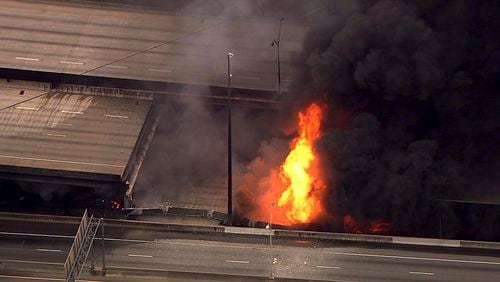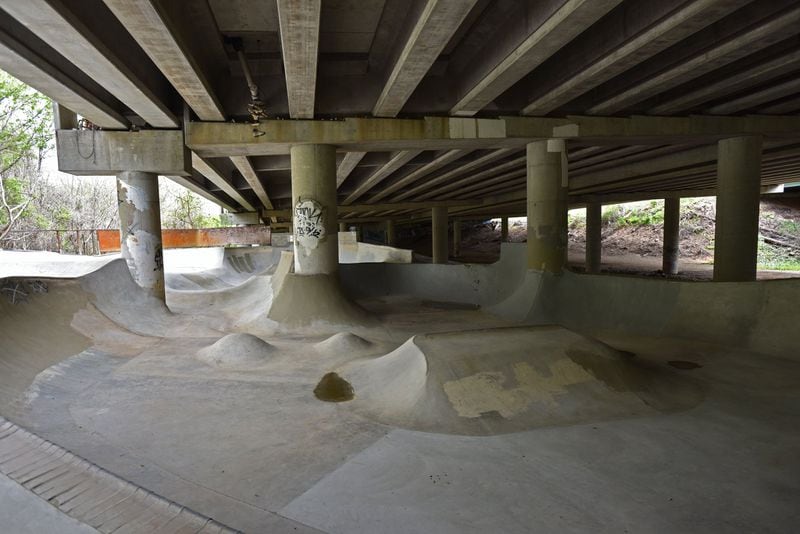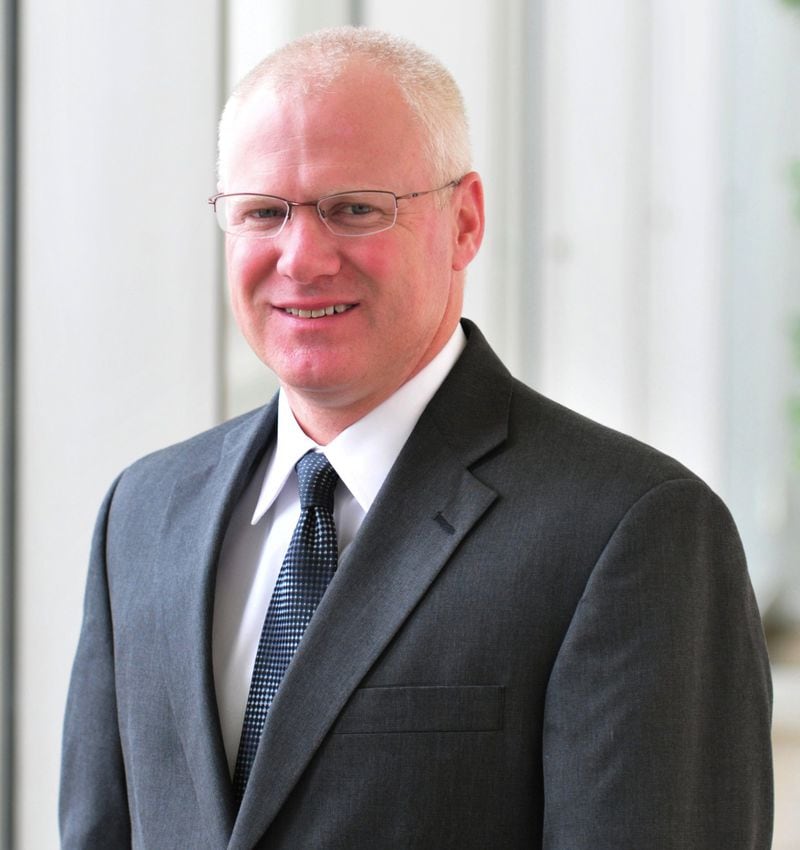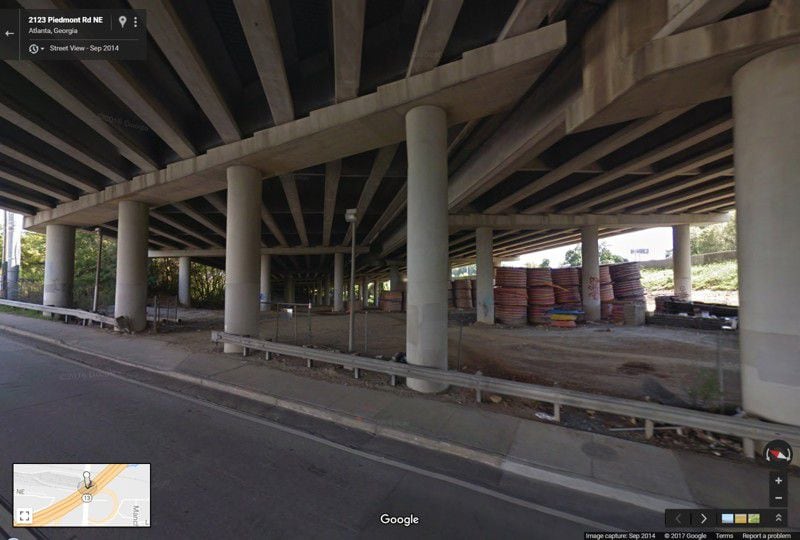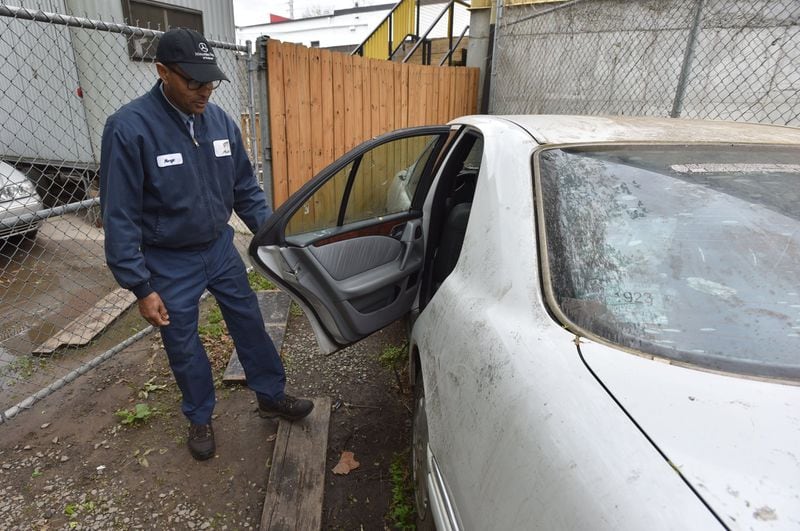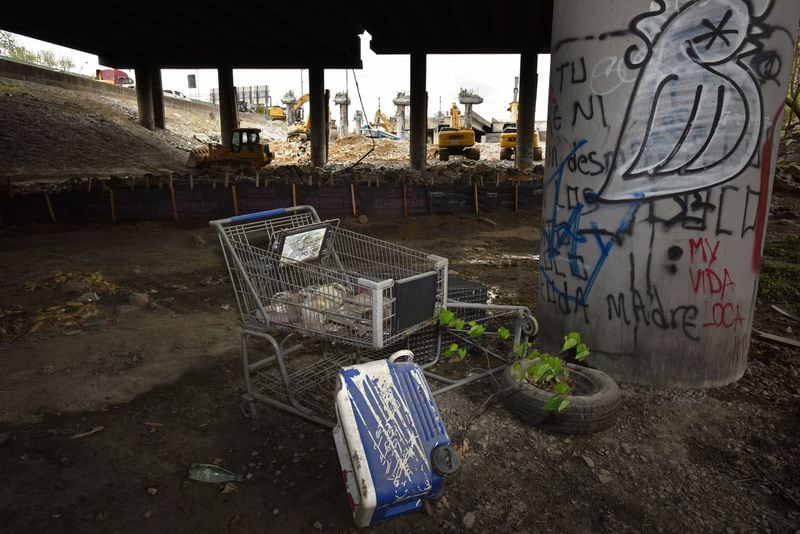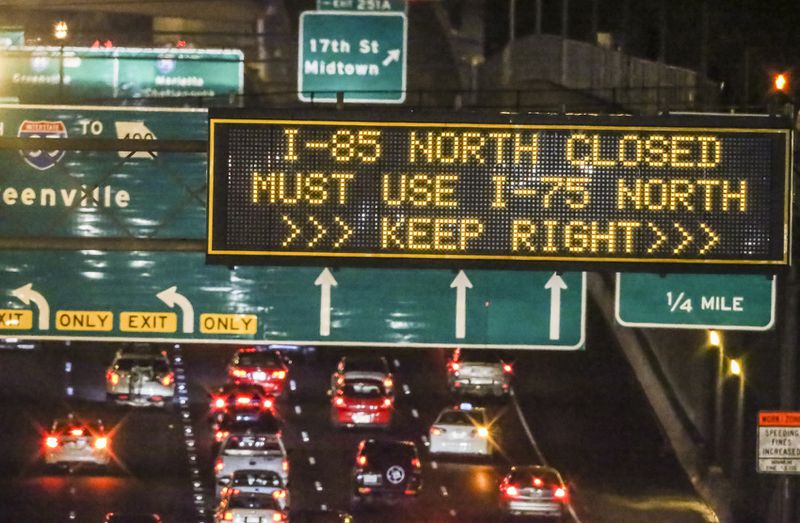Years ago, several tons of high-density plastic piping were stored under an I-85 bridge, left largely out of sight and forgotten.
It’s a similar story for much of Atlanta’s homeless.
On March 30, the two came together with catastrophic results. Police say a 39-year-old homeless man, Basil Eleby, set fire to an upholstered chair, which then ignited the coiled plastic conduit stacked in rows under I-85 near Piedmont Road.
The resulting fire was so large and intense that it chewed through the concrete bridge and its steel beams, eventually causing a large section of the interstate to come crashing down.
TRAFFIC TANGLE: How to cope with your Atlanta commute
MORE: Suspect in I-85 bridge fire indicted on felony charges
Now, Atlantans are grappling with a two-month traffic nightmare while the interstate is repaired. The price tag will easily reach tens of millions of taxpayer dollars. The fiasco has many asking who is to blame.
Inherent in that question is another: Was this fire something that could have been prevented, or was it a freak occurrence?
In a handful of press conferences, state transportation officials acknowledged that the agency placed the materials there, but contended that no one could have foreseen the danger. They also said storing materials under bridges is common around the country.
“I don’t think anyone would have ever thought this kind of thing would happen,” said Russell McMurry, commissioner of the Georgia Department of Transportation.
Police have arrested Eleby, a hapless street dweller who supported himself through odd jobs for local shops. He worked for dollars, sweeping a floor here, washing a few cars there. He also had a rap sheet 19 arrests long and steeped in illicit drugs.
Eleby is charged with arson and criminal damage to property. Late Friday, authorities indicted him and said he had consumed drugs under the bridge before allegedly setting the fire.
He had told police he left the area before the fire began.
Many in the community say he is responsible regardless of his personal problems.
But others say it’s too simple to lay the blame on Eleby alone. They criticize GDOT’s decision to stack burnable material in a location known to attract the homeless.
“Irresponsible, number one. Negligent at a minimum,” said Marcus Coleman, a civic activist who is helping Eleby obtain legal counsel. “There’s no secret that the homeless regularly burn fire outdoors. …The narrative needs to go deeper than just a homeless individual allegedly smoking crack.”
As metro Atlantans think through who is accountable, the state fire marshal and federal investigators with the National Transportation Safety Board are doing the same.
The Atlanta Journal-Constitution spent the past week examining what happened under that bridge, as well as why the materials were stored there and what drew Eleby to that place. The newspaper found security at the site lacking and determined that officials don't know what's stashed under other bridges around the state.
Skateboard bowl shows underpass unsecured
In the wake of the fire, GDOT assured the public that the site - which they owned along with the material - was secured with a chainlink fence and a gate.
But an AJC review of pictures of the site before the collapse as well as a walk through of it afterward found it was hardly secure.
Photos show the gate bent enough to render the attached padlock all but useless. The fence could be easily climbed.
McMurry, the GDOT commissioner, acknowledged the fence was really there to keep people from stealing the conduit rather than to keep people out of the area.
The backside of the underpass, meanwhile, was completely unsecured, the AJC found.
Not far away from the site of the fire, a surreal sight raises even more questions about security under the bridge — a concrete skateboard bowl, about 30 yards long with high walls, humps and dips.
Credit: Hyosub Shin
Credit: Hyosub Shin
Nearby were the unmistakable signs of homeless encampment: plastic coolers, shopping carts, an abundance of plastic bottles, stray shoes and sneakers, the skeletal remains of a bicycle.
GDOT spokeswoman Natalie Dale acknowledged that there was no fencing or other barriers between the skateboard bowl and the conduit. The skateboard area was not permitted nor did GDOT grant permission for its construction, she said.
Gerald Griggs, an attorney with the NAACP, said GDOT has a legal responsibility to keep the public safe from “hazardous” materials. The skateboard bowl, he said, proves GDOT “knew or should have known people were there and it was a potential hazard.”
“When you house a hazardous material in an open and obvious manner, you owe a duty to protect the public,” Griggs said. “Simply saying the material is not hazardous is not protecting the public.”
But some transportation officials say the bridge fire was such an isolated incident that it was impossible to anticipate.
“In hindsight, you go, `geez, why did we do that?’” Maryland Transportation Secretary Pete Rahn said. “But if it’s never happened anywhere else, it’s very hard to (predict) something that unusual.”
Some states don’t allow storage under bridges
The AJC called a handful of states to see if they store materials under bridges. Though it was a small survey, some said they don't.
Minnesota doesn’t allow it, said transportation spokesman Kevin Gutknecht.
“It’s not a policy, it’s a practice – a best practice,” he said.
Pennsylvania bars the storage of flammable, explosive and other dangerous materials. PennDOT spokesman Rich Kirkpatrick said that includes high-density polyethylene, which is the material that caught fire under I-85.
So, just how common is it to store material under Georgia’s bridges? And what’s under there?
GDOT told the AJC that it does not have records showing inventories of materials stored under bridges around the state, or policies for such storage. The agency has no inventory of the material that caught fire.
GDOT Commissioner McMurry has defended his agency's storage of the plastic piping under the bridge. But considering what happened, he's now thinking twice about the idea.
“If we knew then what we know now, we wouldn’t have the material stored in the fashion it was stored,” he said.
Conduit left over from aborted contract
The high-density polyethylene and fiberglass conduit that would go on to ignite was left over from an aborted 2007 contract to install cameras, ramp meters and other electronic traffic devices on Ga. 400, between I-85 and I-285.
McMurry said the state planned to use it in the future to save taxpayers money. GDOT initially stored the conduit at a site at Sidney Marcus Boulevard and Buford Highway. It moved the material under I-85 near Piedmont Road sometime in 2011.
So does GDOT assume any responsibility for the fire?
Dale, the spokeswoman, declined to comment when asked that question, citing the ongoing NTSB investigation.
Locals took Eleby under wing
Many communities have a Basil Eleby. He’s the aimless guy who has nobody, no place to go, and no way to support himself.
Store owners around the intersection of Piedmont Road and Lakeshore Drive took Eleby under wing, giving him errands and chores. They got a good feeling, and he pocketed a few dollars.
Menge Gizachew, who runs GT Auto Service, started years ago by letting Eleby clean the shop floor, vacuum cars and collect garbage.
“That guy is a hopeless guy,” Gizachew said. “I helped him. He respected me.”
Credit: Hyosub Shin
Credit: Hyosub Shin
Over time, he let Eleby use the shop refrigerator and bathroom. Then he let him sleep in a broken-down Mercedes in the back. Eleby threw some ratty blankets in the back seat. The driver’s seat held his toiletries - a tube of toothpaste, a toothbrush.
He was harmless, but sometimes showed flashes of anger, said several shop owners. He didn’t say much, and he seemed a little absent-minded. They didn’t know what he did at night, and they didn’t ask. He seemed sober when they saw him.
Day after day, Eleby rode his bicycle around the area, stopping in place after place, doing a little work here, a little work there.
Bill Turner, who used to repair cars in the neighborhood, tried to help Eleby get in the Army through a recruiter friend. But after one conversation with Eleby, the recruiter said no way.
“I know people gave him bicycles and he sold them,” Turner recalled. “I gave him an iPod. He said he lost it.”
Annette Eleby: `I had to kick him out’
Eleby was born at Grady Memorial Hospital, his mother, Annette Eleby, told the AJC. Her family was poor, and lived in housing projects in Atlanta. Basil had a sister and four brothers. The boys fought all the time. By the time Basil was in his late twenties, he was taking drugs, she said.
“I had to kick him out,” she said.
He'd come back, sometimes breaking into the house when nobody was home. She knew it was him. When he'd leave he'd made sure to lock the front door, protecting the place from other intruders.
His rap sheet indicated Elbey not only had a temper, but could be violent. There were charges of battery and assault. He also was charged with trafficking and possessing cocaine, but never spent more than a few months in jail. Then he was back on the street, riding his bicycle, sleeping in the Mercedes.
At a nearby substance abuse counseling center called the Triangle Club, Eleby was often seen grabbing a cup of coffee and occasionally attending noontime meetings, where he said little.
“He was a creepy guy,” said Michael Kelly, 56, who attends meetings there. “I never involved myself with him.”
This corner is part of Buckhead, but it’s not the upscale condos, expensive shops and towering skyscrapers that most associate with that section of Atlanta. Down the block is a place where men watch nude girls dance and porno videos in booths. Beyond that is the I-85 overpass.
Credit: Hyosub Shin
Credit: Hyosub Shin
The most damaging story about Eleby comes from the homeless woman who ties him to the fire. Sophia Brauer told Channel 2 Action News that she saw a sofa on fire after Eleby placed it on a shopping cart and then reach underneath.
Shortly thereafter, as black smoke mushroomed skyward, she said she ran into Eleby.
“He looked at me,” she told the Channel 2 reporter. “He gave this evil smile and said, ‘Ha, ha, ha. I did that.’”
Johnson: federal regulation unlikely
Some people may have thought such a fire unfathomable before. That has changed.
A flurry of action and review is occurring here and elsewhere in the country, as officials act to prevent another such conflagration.
McMurry has asked the state insurance commissioner and the state fire marshal to review GDOT’s practices for storing construction material. He said he is unaware of any similar material stored under other Georgia bridges.
Transportation officials in numerous states — including Colorado, Florida, Maryland, Minnesota, South Carolina and Tennessee — have begun inspecting their own bridges to determine whether flammable material is stored beneath them.
There are no federal regulations related to storing material under highway bridges, according to a spokesman from the Federal Highway Administration. U.S. Rep. Hank Johnson thinks that’s a problem. The Lithonia Democrat, who sits on the House’s Transportation and Infrastructure Committee, said he would like to see new regulation address the issue, but that is unlikely in Washington’s current political climate.
Credit: JOHN SPINK / AJC
Credit: JOHN SPINK / AJC
“It is incumbent upon the federal government to protect its investments around the country, including its interstate highways and bridges,” Johnson said. “So there should be uniformity in practices and policies in this realm.”
Transportation officials aren't the only ones seeking answers. Law enforcement officials and elected officials wonder what can be done to corral repeat offenders and better care for the homeless.
Dave Wilkinson, president of the Atlanta Police Foundation, said repeat offenders such as Eleby are law enforcement’s biggest challenge. “It does not surprise me at all that that individual was a repeat offender,” he said.
But the criminal justice system can only do so much, said Gwinnett County District Attorney Danny Porter.
“You can arrest people who break the law. You can try and develop an appropriate punishment for that crime,” Porter said. “But it’s really too blunt an instrument to all of a sudden change someone’s life.”
State Sen. Renee Unterman, R-Buford, is heading up a new legislative study on homelessness.
Though she said Eleby is responsible for his actions, Unterman sees the I-85 incident as the tragic result of the state’s failure to care for its homeless residents.
Neighborhood businesses losing customers
For now, the mood at the corner of Piedmont and Lakeshore is one of shock and sadness.
Gizachew, who owns the auto-repair shop where Eleby slept in a car, can’t believe he is charged with such a serious crime.
Bill Turner, who has moved his business from the neighborhood to Decatur, recalled with gallows humor something he said upon hearing about the fire, but before he knew about Eleby’s alleged involvement.
“I guess Basil dropped his crack pipe,” he said.
Meanwhile, the traffic on Piedmont is a mess as construction commences on a new bridge overpass. Neighborhood shops say they're losing business.
Under the bridge, there were no homeless in the encampment, at least on Thursday afternoon. And nobody was zooming around that concrete skateboard bowl.
Nonetheless, GDOT officials say they will start removing the structure soon, according to their written statement to the AJC. The removal, they added, “is part of our commitment to address illegal trespassing on state property and the resulting implications.”
Staff writer Rhonda Cook contributed to this report.
